The Sherlockian review: Dan Brown it’s not
 Reviewing Graham Moore’s The Sherlockian inexorably makes me want to draw comparisons to Dan Brown’s The Da Vinci Code, and for that I apologize for I think Moore’s book superior, but those comparisons are valid nevertheless. As in Dan Brown’s story, we have a expert in a very specific field who recognizes clues and codes and follows them around the world, solving a a very old mystery that’s linked to a clue-filled murder in the present day, and he is aided by a woman who turns out to be something other than what she seems.
Reviewing Graham Moore’s The Sherlockian inexorably makes me want to draw comparisons to Dan Brown’s The Da Vinci Code, and for that I apologize for I think Moore’s book superior, but those comparisons are valid nevertheless. As in Dan Brown’s story, we have a expert in a very specific field who recognizes clues and codes and follows them around the world, solving a a very old mystery that’s linked to a clue-filled murder in the present day, and he is aided by a woman who turns out to be something other than what she seems.
Of course, you could probably make this comparison to many other books — or as my husband said you can always find Jesus on toast somewhere. Fortunately The Sherlockian has nothing to do with the Holy Grail or the Louvre, but instead starts with the apparent murder of one of the Baker Street Irregulars during the birthday celebrations for Sherlock Holmes in New York City. The dead man is Alex Cale, a pre-eminent Sherlockian of the pre-eminent American Holmes society. Cale had claimed to have found the missing volume of the diary of Sir Arthur Conan Doyle, who is either the author of the Holmes stories or, if you are playing “the Great Game” conceit that Holmes existed, John H. Watson’s literary agent.
The missing diary covers the period when Doyle was about to write The Hound of the Baskervilles, the first Holmes story he would write after he famously killed off Holmes in a final confrontation with his nemesis Moriarty at Reichenbach Falls. Sherlockians have often wondered what induced Doyle to return to Holmes and the diary may hold the clue. Fellow Sherlockian Harold White, newly inducted into the Irregulars, a group so exclusive you practically have to kill someone to be invited, decides to play detective, perhaps hoping to impress pretty and clever freelance reporter Sarah Lindsay but mostly wanting to escape his humdrum life by emulating the great detective.
The book alternates chapters following Doyle, from the moment he decides to rid himself of his larger than his own life creation, to his explosive “invitation” to investigate the murder of a young woman found dead in a bath tub with a wedding dress nearby. The investigation leads Doyle and his friend Bram Stoker — yes the author of Dracula — from the East End to a meeting of a women’s suffrage society and to jail after Doyle is suspected being the murderer himself.
The parallels between the two investigations kept me hurriedly turning pages and I confess I read the book in a blaze. There is one “jump the shark” moment, however, that I chose to embrace, despite how over the top it reads. Let’s just say it involves disguises.
The book also intrigues with its hints of dangers, although it never wracks up the body count of a Dan Brown book. Even when Harold is staring down the barrel of a gun it’s hard to get too concerned. Doyle’s story, on the other hand offers more real danger.
Actually, looking back on it, there are many moments that strike one as over the top, especially concerning the involvement of members of the Doyle family. But when you read the afterword you’ll realize some of the improbable complications have basis in fact, something that cannot be said of The Da Vinci Code.
What is common to both books, however, is the protagonist’s familiarity with the source material. Hapless Harold, in over his depth, still makes clever deductions from his knowledge of A Study in Scarlet and other stories from the Canon that make it possible to follow the clues. And like Brown’s Robert Langdon, Harold is whipping us back and forth with his deductions, all the more impressive as they are not aided by tobacco but just a determination to solve a mystery worth of Holmes or his creator.
